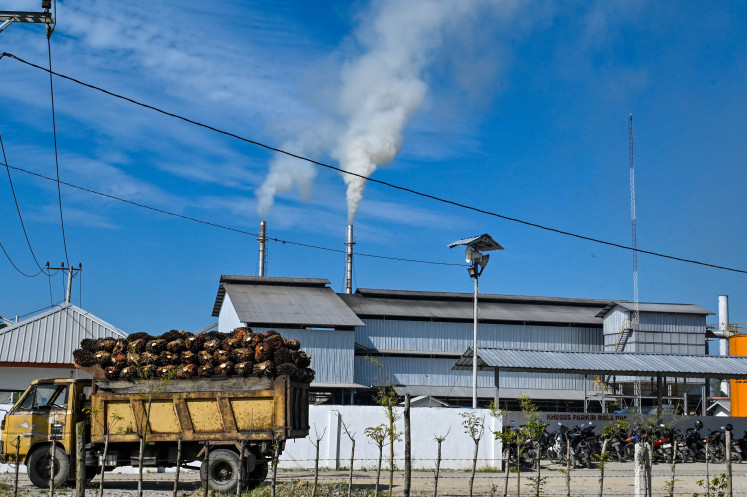Popular Reads
Top Results
Can't find what you're looking for?
View all search resultsPopular Reads
Top Results
Can't find what you're looking for?
View all search resultsA taste of Korea
Enchanted music: Sookmyung Gayageum plays “Let It Be” and “Obladi” of The Beatles during the opening of Korean Culture Festival at Balai Kartini, Jakarta
Change text size
Gift Premium Articles
to Anyone
E
span class="caption" style="width: 398px;">Enchanted music: Sookmyung Gayageum plays “Let It Be” and “Obladi” of The Beatles during the opening of Korean Culture Festival at Balai Kartini, Jakarta. JP/Arief Suhardiman
Familiar with actor Bae Yong Joon? Or pop singer Rain? Or perhaps you have a taste for kimchi? Well, there’s more to South Korean culture than that, as demonstrated in a current cultural festival.
Timed to coincide with the celebration of Korea’s national day, the Korean Culture Festival aims to give Jakartans a glimpse of what the country has in store.
The festival opened last week with a night of mostly traditional performances. If there’s one thing that Indonesia could learn from South Korea, it is its effort in going the extra mile to ensure that its cultural heritage is preserved.
“We also have problems with the younger generation liking pop culture more than traditional ones. But there are efforts to keep the tradition alive and appealing for them,” South Korean ambassador Kim Ho-young said last week.
It’s an effort that has already seen results.
On the move: Korea’s famous River Crew B-boy charms youngsters, both Korean and Indonesians, when they appeared on the stage. JP/Arief Suhardiman
On the opening night, a 2000-year-old traditional dance called hwagwanmu was performed by young dancers, while energetic young performers captivated the audience through the folk dance namsadang.
Performed by five women wearing colorful costumes with long draping sleeves swaying, hwagwanmu was developed as a form of entertainment for the king and his aristocrats. Namsadang is said to have been formed spontaneously by common people for their own entertainment.
The differences between the two performances were apparent in the audience’s response.
People mostly sat quietly during the hwagwanmu, enjoying the graceful movements. But, as five energetic men took the stage, skillfully moving in a way that made the white ribbon attached to their hats move as if dancing with them, the audience clapped along with the rhythmic drum beat.
For a short 10 minutes, the South Jakartan concert hall came to life.
The Korean Culture and Information Service also invited traditional musicians ranging from string instrumentalists playing gayageum sanjo to singers of gyeonggi folk songs.
Both are currently on the list of the country’s Important Intangible Cultural Assets.
But Korea has more than purely traditional performances. With a twist of fusion between the old and the new, the opening night closed with a performance of breakdancers B-Boys moving to the music played by the traditional gayageum ensemble.
For those who missed the opening night, the festival still has a lot to offer.
Five Korean movies are to be screened for the public for free twice a day. Korean movie buffs can choose from dramas such as Christmas in August and Beyond the Years, comedy The Show Must Go On and historical epic The Divine Weapon.
Whatever the genre, Korean movies are known to always include a peek at its culture, be it ancient or modern.
And who says that Korea is popular only for the modern city-girl clothing widely sold in trade centers and online?
Going back a millennium, the country has its own embroidery craft, a kind of Asian-style that came all the way from Persia, across India and China.
During the 14th-century Joeseon dynasty, the art of embroidery was taken on by upper-class women who were not able to freely leave the house. Thus, their hours were spent sewing stitch by stitch in brilliantly colored thread.
One of those who have kept the tradition alive is Han Sang-soo. Some 100 of her works collected over the past 30 years are on display at the National Museum. Sang-soo herself has been designated a living human cultural property in the art of embroidery since 1984.
So, want a taste of Korea? A movie, a cultural discussion or a bite of persimmon, perhaps?
Korean Movie Show
Until Oct. 18 at the Blitzmegaplex Pacific Place, South Jakarta
Embroidery Exhibition
Until Oct. 18 at the National Museum, Central Jakarta
Korean Agricultural Exhibition
Oct. 16 – Oct. 18 at Grand Indonesia, Central Jakarta
Music Concert
Oct. 15 at the Usmar Ismail Hall, Kuningan, South Jakarta
All events are free of charge. For more information, contact the
Korean Embassy on (021) 520-1915.











